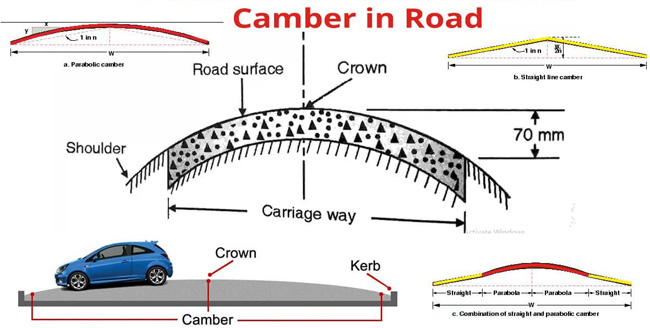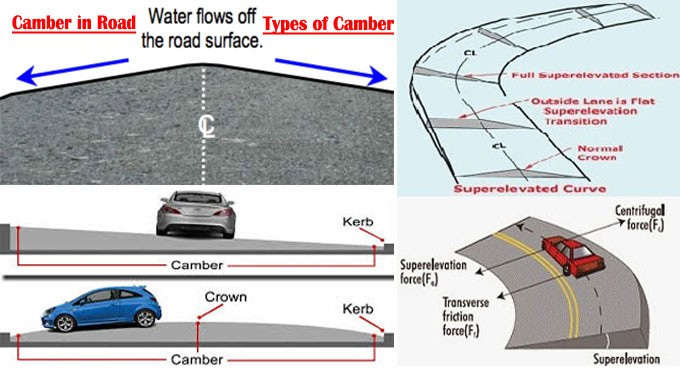NEWS | SOFTWARE | SHEET
Types of Road Camber and Superelevation
The camber has been found on highways or on straight roads. The camber refers to the slope in the transverse direction, which prevents the accumulation of water on the road surface by draining out the rainwater. Thus, camber helps to keep the cars from sliding and also helps to prevent damage to the pavement. This crown-shaped part of the road helps to make the road surface last longer.

Construction of Camber in the Road
- The camber has been constructed through elevating the centre of the carriageway, which helps to create a crown shape or the highest point along the centerline of the road.
- In the case of improving the surface drainage system of the road surface at the horizontal curves along with the super elevation, the router edge of the pavement can be elevated relative to the inner edge of the pavement.
- The camber has been determined in the percentage value. A ratio of 1 in ‘n’ is defined for the design of the camber.
Effectiveness of Constructing a Camber in the Road
There are several important aspects of constructing a camber in the road, which are:
Preventing water damage
The camber helps to keep the water from seeping into the subgrade of the road. This helps to prevent the cracks on the roads and other water-related damage.
Providing stability
The camber helps to counteract the centrifugal forces which act on the car while it turns. This helps to keep the tiers in better connection with the road and also helps to prevent incidents like skidding. Thus, a camber helps to provide stability to the vehicles.
Protecting the surface of the pavement
In the asphalt layer of the road pavement, the aggregate particles can be loosened because of standing water on it. This leads to the breakdown of the road pavement. In this context, the installation of the proper camber helps to direct the water away from the road surface and thus prevents the breakdown of the road pavement.
Providing road safety
The camber helps to provide safer driving conditions. In addition, the camber also helps to minimise the risks of hydroplaning during wet weather conditions, thus ensuring road safety.
Increasing longevity
The foundation of the road has been protected by the camber, which enhances the lifespan of the road.
Promoting smooth driving
The camber also helps to provide a smoother driving experience by minimising the uneven settling of the road surface, as well as promoting even tire wear.
Different types of camber in road design
The types of camber depend upon the type of pavement surface on the road. The different types of camber include:
Barrel camber
This type of camber has been constructed with a continuous curve. In this context, the curve is elliptical or parabolic. The surface shape has been kept steeper near the edges and also flat in the middle in the case of the barrel camber.
Sloped camber
In these types of camber, two straight slopes have emerged at the centre. This kind of camber is appropriate for the rigid pavement surface, including concrete roads.
Two straight-line cambers
Two straight lines have been flattened near the crown in this type of camber. In addition, these lines become steeper near the edges.
Composite camber
In the composite camber, two straight-line slopes have been used along with a parabola at the centre.
Factors influencing the design of the camber
Type of road pavement
In the case of the bituminous or concrete pavement, less camber is required, as water does not penetrate readily in these types of pavements.
Volume of the traffic
In the case of the high-traffic roads, a slightly steeper camber is appropriate to handle the runoff of the water.
Rainfall patterns
The design of the camber has been influenced by the rainfall patterns. The steeper slope has been required for those areas which are prone to heavy downpours. This helps to ensure that the water flows on the roads within a few time.
Advantages of camber in road design
There are several advantages of constructing camber in the road design, which are:
- The runoff of the rainwater has been done quickly with the help of the camber. As a result, the rainwater cannot soak into the road foundations, and thus, the weakening of the road can be prevented with the help of the camber.
- The road pavement acts as a barrier, which helps to keep the road surface from soaking into the soil below the road.
- With the help of the camber, the water does not get into the asphalt layer of the road pavement.
- The pavement has been left to dry after rain, as the rainwater drained off within a few hours from the road pavement.
- The camber helps to prevent the pooling of water in the cracks or depressions on the surface of the road.


